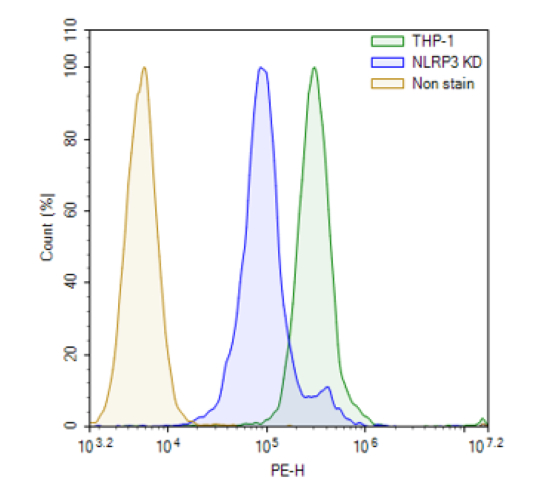NLRP3 Knockdown THP-1 Cell Pool
NLRP3 Knockdown THP-1 Cell Pool is a cell pool of THP-1 human monocytic cells. This cell pool was generated by using NLRP3 Human shRNA Lentivirus (BPS Bioscience #82122) to create a THP-1 cell pool with stable knockdown of NLRP3 (NLR family pyrin domain containing 3). THP-1 cells are the most commonly used model cell line in the study of inflammasome activation as they express high levels of NLRP3 and pro-caspase-1.
Purchase of this cell line is for research purposes only; commercial use requires a separate license. View the full terms and conditions.
Media Required for Cell Culture
| Name | Ordering Information |
| Thaw Medium 2 | BPS Bioscience #60184 |
| Growth Medium 2M | BPS Bioscience #78181 |
The cell line has been screened to confirm the absence of Mycoplasma species.
NOD, LRR and pyrin domain containing 3 (NLRP3), also known as NALP3 and cryopyrin, is a pattern recognition receptor (PRR) of the NRL (NOD-like receptor) subfamily. It is involved in detection of microbes, endogenous and exogenous stress signals. It is expressed in macrophages and when bound to PYCARD (adaptor ASC protein) forms a caspase-1 activating complex named NRLP3 inflammasome. NLRP3 detects uric acid and extracellular ATP in damaged, and once activated it leads to an immune response. Upon activation NLRP3 inflammasome releases its inactive form partners, HSP90 and SGT1, and binds to PYCARD and caspase-1. Caspase-1 initiates the processing and release of pro-inflammatory cytokines IL-1β and IL-18 and gasdermin D-mediated pyroptotic cell death. Mutations in NLRP3 are known to cause autoinflammatory and neuroinflammatory diseases, such as Alzheimer’s, Parkinson’s, and prion disease. NLRP3 is the most extensively studied inflammasome protein to date due to its array of activators and aberrant activation in several inflammatory diseases. Studies into its function and inhibition can lead to the development of therapeutic avenues for the treatment of auto-inflammatory diseases.
Swanson K., et al., 2019 Nature Reviews Immunology 19:477-489.


